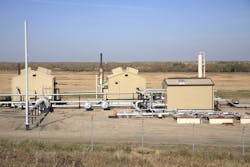Reciprocating compressors take suction gas and compresses it by submitting it to a reduction in volume imposed by a reciprocating piston. This cycle is then repeated over and over again.
Many operation and process engineers asked how to increase the discharge pressure of a reciprocating compressor, so this article explains how a reciprocating compressor develops a discharge pressure.
The discharge pressure is not actually built up by a reciprocating compressor. Rather, it is a characteristic result of the system’s resistance to flow (downstream system). The compressor merely moves or displaces an adjusted volumetric rate to overcome the resistance to flow inherent in the downstream system. The resistance in the downstream system, which contains piping, facilities and valves, determines the amount of resistance and the required discharge pressures. The reciprocating compressor’s discharge pressure must meet and overcome the downstream resistance while displacing an adjusted volumetric gas rate.
The compressor simply reacts to discharge conditions, but the amount of work and heat developed is a function of the ratio of suction to discharge pressure. While the compressor will almost magically rise to achieve any given discharge pressure, it will only do so while the work is less than the maximum at which the driver can operate, and the discharge temperatures are lower than the allowable discharge temperature.
Flow of gas
As noted, the pressure is adjusted by the downstream resistance, and then selecting the proper control valve and correctly adjusting the hydraulic downstream parameters. If a linear control valve is used, a 5 percent change in valve position (after flow is initiated) is about a 5 percent change in the mass flow rate.
The reciprocating compressor may be called a constant volume compressor, but this is true only in a limited pressure range. If suction or discharge pressure is varied enough, the flow rate could change because of the change in volumetric efficiency of the compressor’s first stage. The compressor power will have a peak and then fall again. In a multistage compressor, the effect of the change in pressures might be less than a single-stage compressor. The volume pushed through the compressor will vary more as the suction pressure changes because this has a direct effect on the volumetric efficiency of the first stage, which controls the flow.
Upstream facilities
Liquid carry-over and dirty gas could be damaging to a reciprocating compressor. Suction scrubbers at each stage are necessary for any reciprocating compressor, except when gas services are 100 percent clean and dry. Shutdown (trip) for high liquid level is usually required for inlet and interstage separators.
Pressurization and purge bypass for the main shutoff valve is usually specified for ease in commissioning. Any bypass to main shutoff valves can offer some operational flexibility. Considering the complexity of a usual reciprocating compressor system, possible operating scenarios and required operational flexibility, a bypass for pressurization and purge is recommended. As a rough indication, the bypass size could be 15 to 20 percent of the main line size. For example, a 2-inch bypass would work for a 10- or 12-inch main line.
Pulsation could be an issue for this small-size bypass, so there are some limitations. The bypass at the suction is required for pressurization and purge. At the discharge it might not be required or come with the compressor packages, but it still might be useful for some packages if pulsation and other disadvantages can be managed. It may offer operational benefits for package commissioning and operation, and it could provide smooth and controlled operation in the discharge valve.
Piping & downstream facilities
On a reciprocating compressor, check valves can be found in several places. Although cylinder valves of a reciprocating compressor may act like a check valve, independent check valves are still needed. One or two check valves should be provided at the discharge line to ensure that gas cannot flow back to the compressor when it shuts down after it has been compressed into the downstream system. A check valve at the package discharge is necessary to keep the discharge system from backflow by providing instant and fast backflow prevention. In other words, the valve can provide backflow prevention benefits in dynamic situations for a reciprocating compressor package.
Other valves such as a control valve, shutoff valve and actuated valve could prevent backflow. In a static situation in theory, they are sufficient to prevent backflow, but a check valve in a compressor package can provide an instant backflow stop and might be useful given the complex operation of a reciprocating compressor package. Other important observations include the following:
- Actuated valves and control valves need times to close, 3 to 7 seconds, depending on their size.
- Even two check valves at the compressor discharge or at different locations have been used in some compressor packages.
- The check valve location could affect concepts for pressure relief valve sizing. If the proper check valve is not provided, the relief valve operation should be re-evaluated.
Gas backflow is possible, such as when compressor is not working or something malfunctions. To assess whether an additional check valve near a compressor package battery limit is needed, accurate dynamic simulations can test all operating and malfunction scenarios. This study might not be feasible in a short time of package design, and if not, considering a check valve is safe.
Upon shutdown, the blow-down valve "blows down" any gas pressure inside the pipe between the reciprocating compressor and the downstream system to near zero bar pressure to help the compressor on startup. The check valve between this discharge pipe and the downstream system ensures that only the small pipe is blown down and not the whole downstream system. If an operator hears gas leaking when the compressor is stopped, it is usually the check valve, not the instrument or facility, that is leaking gas.
Capacity control
Speed control can be used for the capacity control of a reciprocating compressor. This depends on the speed variation allowed by the driver and the compressor frame capability. Suction pressure variations or recycle control valve can also be used for the capacity control. Recycling is not preferred for reciprocating compressors because it is less efficient. Instead, speed control, suction unloaders and clearance volume pockets are more efficient and popular.
A pressure control valve could be installed at the suction of a reciprocating compressor for additional capacity control. In some reciprocating compressor packages, a pressure control valve at the suction is needed to eliminate the gas blow that rises during high suction pressures. Too often a reciprocating compressor cannot handle suction pressures above a certain value or below a limit, for example, due to the rod load limitations.
Therefore, a suction control valve can control the suction pressure of the compressor and the suction flow rate while the compressor is starting. In other words, it can provide additional control over the suction in high suction pressure cases and other scenarios, which might offer flexibility to the operator considering the range of variations in some compressors.
Some reciprocating compressor packages may not properly accommodate their surrounding facilities in spite of their design. One solution is to operate a control valve at the suction to provide some operational flexibility to let machine match with the system.
An important case for this pressure control valve is when the pressure at suction is high enough but the gas consumption at the system is so high (or expected to be so high) that the compressor cannot be operated in such conditions. This control valve allows for condition adjustments and operations can be continued. This is also applicable when an operator wants to increase the compressed gas volume in the system, and the control valve needs to adjust the suction conditions for optimum operation.
Often for reciprocating compressors with a wide range of suction pressures or a wide range of flow, two or sometimes three cylinders should be allocated for each stage, in addition to suction valve unloaders and other capacity control methods. While one cylinder per stage is preferred, two can help achieve the flexibility needed. However, this should be a last option because one cylinder per stage is desired for many applications because of costs and reliability.
Pulsation & dynamic
Proper pulsation and dynamic analysis are required for any reciprocating compressor. They usually involve a detailed acoustical analysis to limit pulsation and unbalanced forces, as well as a detailed mechanical analysis using a finite element model to avoid mechanical natural frequencies coincident with significant excitation forces. These studies usually consider pulsation and acoustical forces up to 10 times the compressor speed. For example, for a 900 rpm, 15 hertz (Hz) reciprocating compressor, dynamic and acoustical forces up to 150 Hz or more should be evaluated. Internally localized compressor cylinder gas passage acoustic resonance, shell mode vibration in piping and vessels, and vibration on small bore piping and instrument attachments should usually be included in the scope of these analyses and studies to avoid any significant vibration issue or failure.
The pulsation and dynamic analysis should be extended to the off-skid piping up to the major gas volumes upstream of and downstream from the compressor package. As a rough indication, the study scope should include 25 to 70 meters of piping at each side to a major vessel or equipment with a significant gas volume that can compensate the pulsation and dynamic forces.
The forced response analysis of a reciprocating compressor should include cylinders, distance pieces, crankcases, pulsation bottles and close-coupled piping, scrubbers and any important item within the compressor skid. In most cases and particularly for large, high-power frames, it is necessary to include a full frame model in the analysis to accurately predict vibration and stress levels on the bottles and piping.
Skid dynamic analysis uses a finite element model to calculate the vibration and stress of the skid beams. It also calculates major components on the skid in response to the dynamic loads in the reciprocating compressor and acoustical forces at the compressor fundamental and second-order frequencies.
Vibration and stress levels are compared to defined vibration and stress guidelines to evaluate the design of compressor package.
Amin Almasi is a senior rotating machinery consultant in Australia. He is a chartered professional engineer of Engineers Australia and IMechE and holds bachelor’s and master’s degrees in mechanical engineering and RPEQ. He is an active member of Engineers Australia, IMechE, ASME and SPE and has authored more than 100 papers and articles dealing with rotating equipment, condition monitoring, offshore, subsea and reliability.



